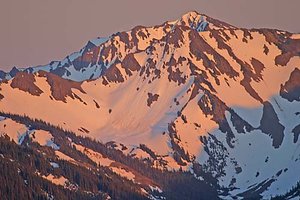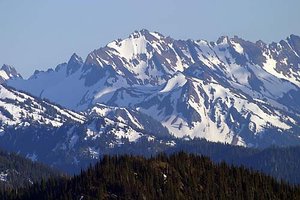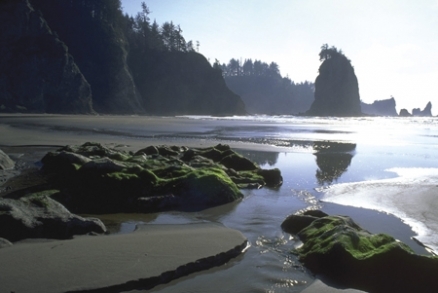Olympic National Park, United States
| Topics: |
Contents
- 1 Introduction The Olympic National Park (47°29'-48°16'N, 123°07'-124°43'W) is a World Heritage Site in Washington, United States of America. (Olympic National Park, United States)
- 2 Geographical Location
- 3 Date and History of Establishment
- 4 Area
- 5 Land Tenure
- 6 Altitude
- 7 Physical Features
- 8 Climate
- 9 Vegetation
- 10 Fauna
- 11 Cultural Heritage
- 12 Local Human Population
- 13 Visitors and Visitor Facilities
- 14 Scientific Research and Facilities
- 15 Conservation Value
- 16 Conservation Management
- 17 IUCN Management Category
- 18 Further Reading
Introduction The Olympic National Park (47°29'-48°16'N, 123°07'-124°43'W) is a World Heritage Site in Washington, United States of America. (Olympic National Park, United States)
Geographical Location
The Olympic National Park (47°29'-48°16'N, 123°07'-124°43'W) lies on the Olympic Peninsula, in the northwestern corner of the United States bordering Canada.
Date and History of Establishment
Declared a national park on 29 June 1938. Several boundary changes have occurred since, namely: the addition of the Pacific Coastal Area and Queets River Corridor on 6 January 1953; expansion of the coastal unit to include Point of Arches and Shi Beachin in 1976; and the inclusion of the intertidal area in 1986. Accepted as a biosphere reserve in June 1976, and inscribed on the World Heritage List in 1981.
Area
 Olympic National Park (Source: Marietta.edu)
Olympic National Park (Source: Marietta.edu) Comprises 369,659.8 hectares (ha) in two units: 352,335 h) in the Olympic Mountains and 17,324.8 ha in the Pacific Coastal Area.
Land Tenure
99% Federal Government; 1% privately owned.
Altitude
Ranges from sea level to 2,428 meters (m).
Physical Features
The park is divided into two segments: a mountainous core and a separate coastal strip, stretching for 90 kilometers (km) along the Pacific coast. The rugged features of Olympic National Park are the result of the collision of drifting continental plates. When normal subduction processes associated with continental drift, moved further westward out to sea, an upwelling of submarine sediments and volcanic material followed. A dome, 95 km in diameter, was created consisting of contorted beds of shale, slate and sandstone with interspersed lavas. The Olympic Mountains are the highest in this coastal range bounding the Pacific ocean, and are the central topographic feature of the park. They are of sedimentary origin and range from late Tertiary to Quaternary age. The action of 11 major rivers and many glaciers (60 of which remain) has carved the dome into a vast array of deep canyons and jagged peaks. Ancient 1,000 m thick continental ice sheets transported non-native granite up to 200 km from British Columbia, Canada.
Climate
Climate is moderate and temperatures rarely drop below -7°C or rise above 27°C. Mean annual temperatures are 10°C at lower elevations with a yearly range from 1°C to 17°C. Storms account for 4,000 millimeters (mm) of annual precipitation in western rain forest valleys and 5,000 mm on Mount Olympus; only 53 km to the north-east precipitation falls to 300 mm, creating the greatest precipitation gradient per distance in the world at a temperate latitude.
Vegetation
 Olympic National Park (Source: Marietta.edu)
Olympic National Park (Source: Marietta.edu) The five major vegetation zones are: 1) Sitka spruce zone (36,284 ha), 10%), containing temperate rain forest and characterized by Sitka spruce Picea sitchensis, western hemlock Tsuga heterophylla, western red cedar Thuja plicata, and big leaf maple Acer macrophyllum along the coast and in valley bottoms. 2) Lowland forest zone (36,284 ha), 10%), characterized by western hemlock Tsuga heterophylla, western red cedar Thuja plicata, grand fir Abies grandis and Douglas fir Pseudotsuga menziesii, an extensive fire sub-climax species up to 550 m in elevation. 3) Montane zone (181,425 ha), 50%), characterized by western hemlock Tsuga heterophylla in lower and drier habitats, Pacific silver fir Abies amabilis in higher and damper habitats and Douglas fir Pseudotsuga menziesii as an extensive sub-climax in eastern portions of the park (generally from 550-1,100 m). 4) Subalpine zone (72,570 ha), 20%), characterized by mountain hemlock Tsuga mertensiana in the western portion of the park and subalpine fir Abies lasiocarpa in the eastern portion, including extensive park-like meadows (generally from 1,100 m to around 1,600 m). 5) Alpine/glaciers region (36,284 ha), 10%), characterized by red mountain heather Phyllodoce empetriformis, tall sedge Carex spectabilis, spreading phlox Phlox diffusa and large tracts of snow and ice (highest ridge and mountain tops). The park contains 500 taxa of vascular plants, of which at least 13 are endemic, including Olympic mountain milk-vetch Astraglaus austrlis var. olympicus, Piper's bellflower Campanula piperi, Olympic mountain daisy Erigeron flettii, rockmat Petrophytum hendersonii, Olympic butterweed Senecio neowebsteri and Flett's violet Viola flettii; and seven varieties: Piper's bellflower white form Campanula piperi v. soveregniana, magenta paintbrush Castilleja parviflora v. olympica, wallflower Erysimum arenicola v. arenicola, white coiled-beak lousewort Pedicularis bracteosa v. astrosanguinea, kittentails Synthris pinnatifida v. lanuginosa and Olympic rockcress Arabis furcata v. olympica.
Fauna
180 species of birds and 50 species of mammals, with at least seven endemic taxa occur. The native fauna is intact except for the local subspecies of wolf Canis lupus nubilus, which was extirpated by man before the park was established. The large coastal subspecies of elk Cervus elaphus roosevelti was first described in the Olympic Mountains and its protection was an important reason for establishing the park, with an estimated 3,000-5,000 animals in the area. Rocky Mountain goat Oreamnos americanus was introduced before the park was created and now has an estimated population of 300 (reduced from about 1,200 in 1983). Endemic Olympic fauna includes: Olympic marmot Marmota olympus, Beardslee trout Salmo gairdneri beardsleei, Crescenti trout Salmo clarkii crescentis, Olympic mole Scapanus townsendi olympicus, short-tailed weasel Mustela erminea olympicus, Olympic chipmunk Tamias amoenus caurinus and Olympic mazama pocket gopher Thomomys mazama melanopes. Other noteworthy species are cougar Felis concolor, coyote Canus latrans, mule deer Odocoileus hemionus ssp columbianus, black bear Ursus americanus, snowshoe hare Lepus americanus washingtonii, peregrine falcon Falco peregrinus and spotted owl Strix occidentalis. Over 50 species of smaller animals have been identified. Nearly 1,000 km of streams and rivers in the park are inhabited by some 20 native fish species, including seven species of salmon, and trout that are anadromous.
Cultural Heritage
A few abandoned homestead clearings (0.5 to 5 ha) are evident in certain lowland valleys, and several are designated as historical sites. Several native American tribes have reservations near to or adjoining park lands, and continue to fish and gather plants for religious and ceremonial purposes.
Local Human Population
Towns on the peninsula are small (Port Angeles has 16,500 inhabitants) but less than 80 km to the east, the Seattle-Tacoma urban complex has a population of nearly two million.
Visitors and Visitor Facilities
Over three million people visit the park annually but most stay near the 267 km of road that peripherally enter the mountain valleys and skirt about 25% of the Pacific Ocean [[coast]line]. About 1,000 km of trails interconnect the mountainous interior for foot and horse passage. There are at least 125,000 overnight hikers each year, many of which hike along the ocean coastline. Nine ranger stations and nine seasonal tourist facilities are located around the periphery of the park. Several small towns, as well as the cities of Port Angeles, Forks, and Sequim all offer tourist amenities.
Scientific Research and Facilities
Since 1971 management studies by the park staff have extensively investigated human recreational impact and its mitigation in back-country camping areas. Other management problems needing research attention include; baseline surveys of all major biotic subsystems (terrestrial and aquatic) as benchmarks for sound management strategies; the ecological role and appropriate management of wildfire, population ecology and protection of Cervus elaphus roosevelti and its role as a consumer in forest communities; status and protective measures needed for native genetic stocks of anadromous fish species; and status and protection of alpine plant endemics with increasing recreational use. Distinctive plant communities have been described by Fonda and Bliss 1969, Kuramoto and Bliss 1970, and Fonda 1974. There is a 5,000-specimen study collection and reference library.
Conservation Value
Olympic National Park is an area of outstanding natural beauty combining [[coast]line] and numerous offshore islands with forested mountain slopes, alpine parklands and glacier capped [[mountain]s]. The park contains the largest and best example of virgin temperate rain forest in the western hemisphere, the largest intact stand of coniferous forest in the continuous forty eight states, and the largest truly wild herd of Roosevelt elk.
Conservation Management
The park is strictly protected under Act of Congress of 29 June 1938. However, fishing is permitted. There are various management plans for the area. A goat experimental management program was initiated in April 1981, and planning is currently in progress to remove the remaining mountain goats from the park. About 96% of the park is managed as a wilderness area and 4%, including all public facilities, as a natural area.
Management Constraints
The core of the Olympic Mountains is still largely undisturbed mountain and forest. No timber harvesting is permitted in the park but there is some illegal felling at the boundaries. Introduced mountain goats Oreamnos americanus have had an impact on high elevation communities. Research has suggested they have reduced plant cover, increased erosion and shifted plant community dominants toward more resistantor less palatable species, and they have been recorded feeding on at least three of the endemic plant species. The 1% of the park which is privately owned, is visually obtrusive. The park has suffered two large oil spills from offshore shipping since 1988 and remains vulnerable to these accidents. Air and water quality in [[coastal] areas] is also threatened by large-scale applications of herbicides in timber-producing areas adjacent to the park. Tourists and other visitors have an adverse effect on the park.
Staff
There are 126 permanent and 154 seasonal employees.
Budget
US $7,600,00 in 1995.
IUCN Management Category
- II (National Park)
- Biosphere Reserve
- Natural World Heritage Site - Criteria ii, iii
Further Reading
Numerous publications are available in the park library, Pioneer Memorial Visitor Centre, Port Angeles.
- Fonda, R.W. (1974). Forest succession in relation to river terrace development in Olympic National Park, Washington Ecology 55(5): 927-942.
- Fonda, R.W. and Bliss, L.C. (1969). Forest vegetation of the montane and subalpine zones, Olympic Mountains, Washington. Ecological Monographs 39: 271-301.
- Houston, D.B., Schreiner, E.G. and Moorhead, B.B. (1994). Mountain Goats in Olympic National Park: Biology and Management of an introduced species. Scientific Monograph NPS/NROLYM/NRSM 94/25. U.S. Department of the Interior, National Park Service.
- Kuramoto, R.T. and Bliss, L.C. (1970). Ecology of subalpine meadows in the Olympic Mountains, Washington. Ecological Monographs 40: 317-347.
- Tabor, R.W. (1975). Guide to the geology of Olympic National Park. University of Washington Press, Seattle. ISBN: 0295953950.
| Disclaimer: This article is taken wholly from, or contains information that was originally published by, the United Nations Environment Programme-World Conservation Monitoring Centre (UNEP-WCMC). Topic editors and authors for the Encyclopedia of Earth may have edited its content or added new information. The use of information from the United Nations Environment Programme-World Conservation Monitoring Centre (UNEP-WCMC) should not be construed as support for or endorsement by that organization for any new information added by EoE personnel, or for any editing of the original content. |
